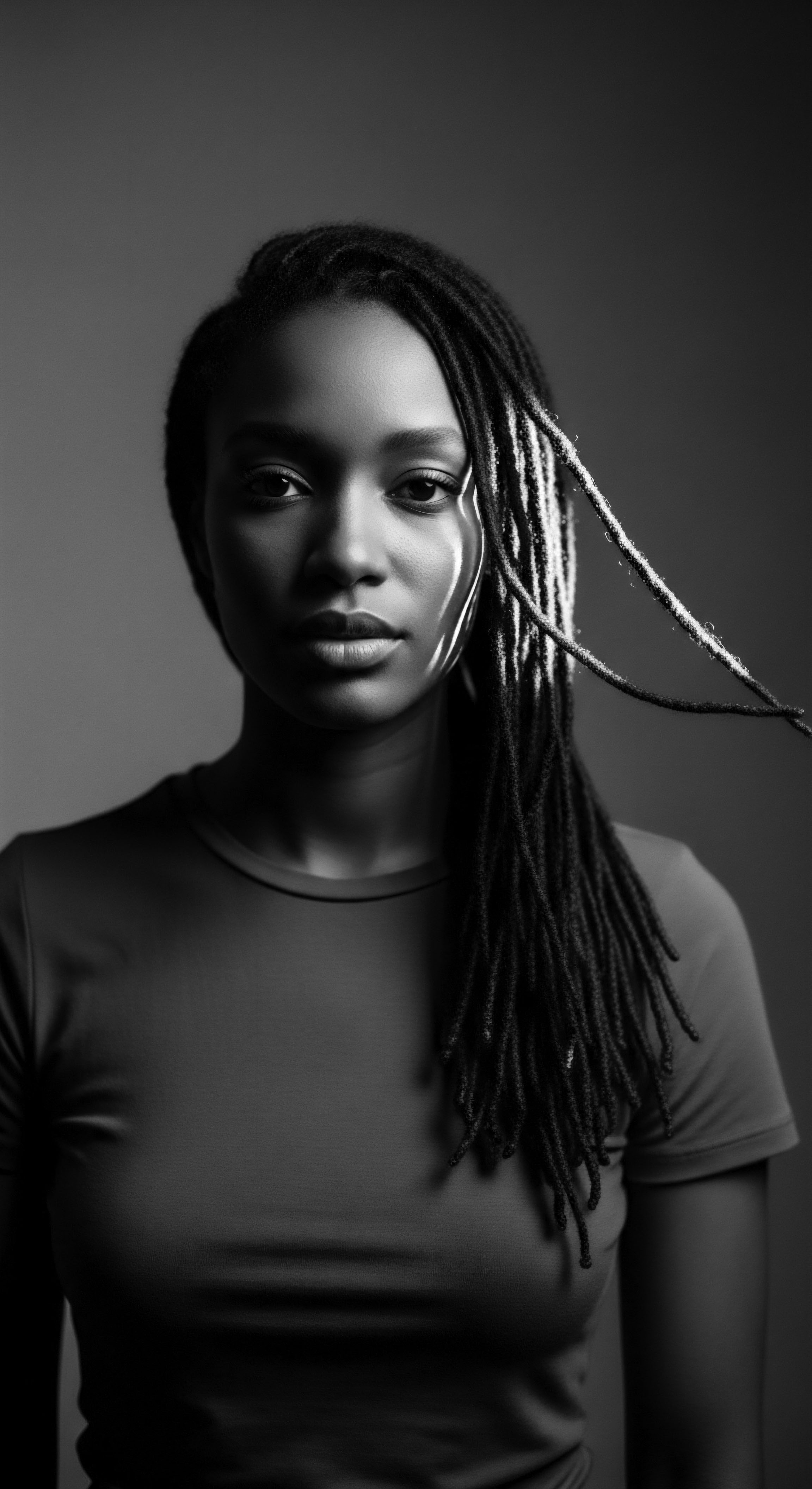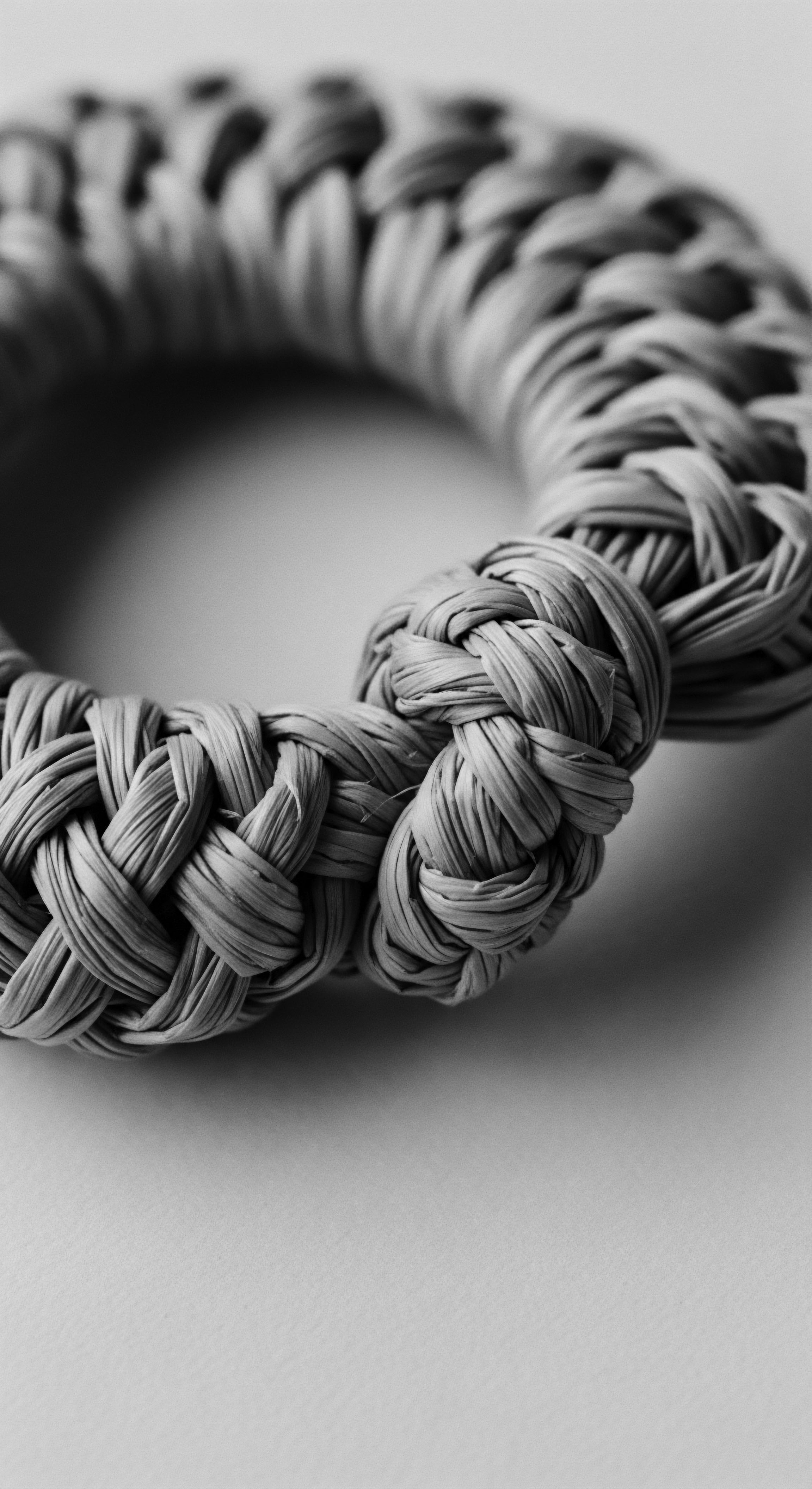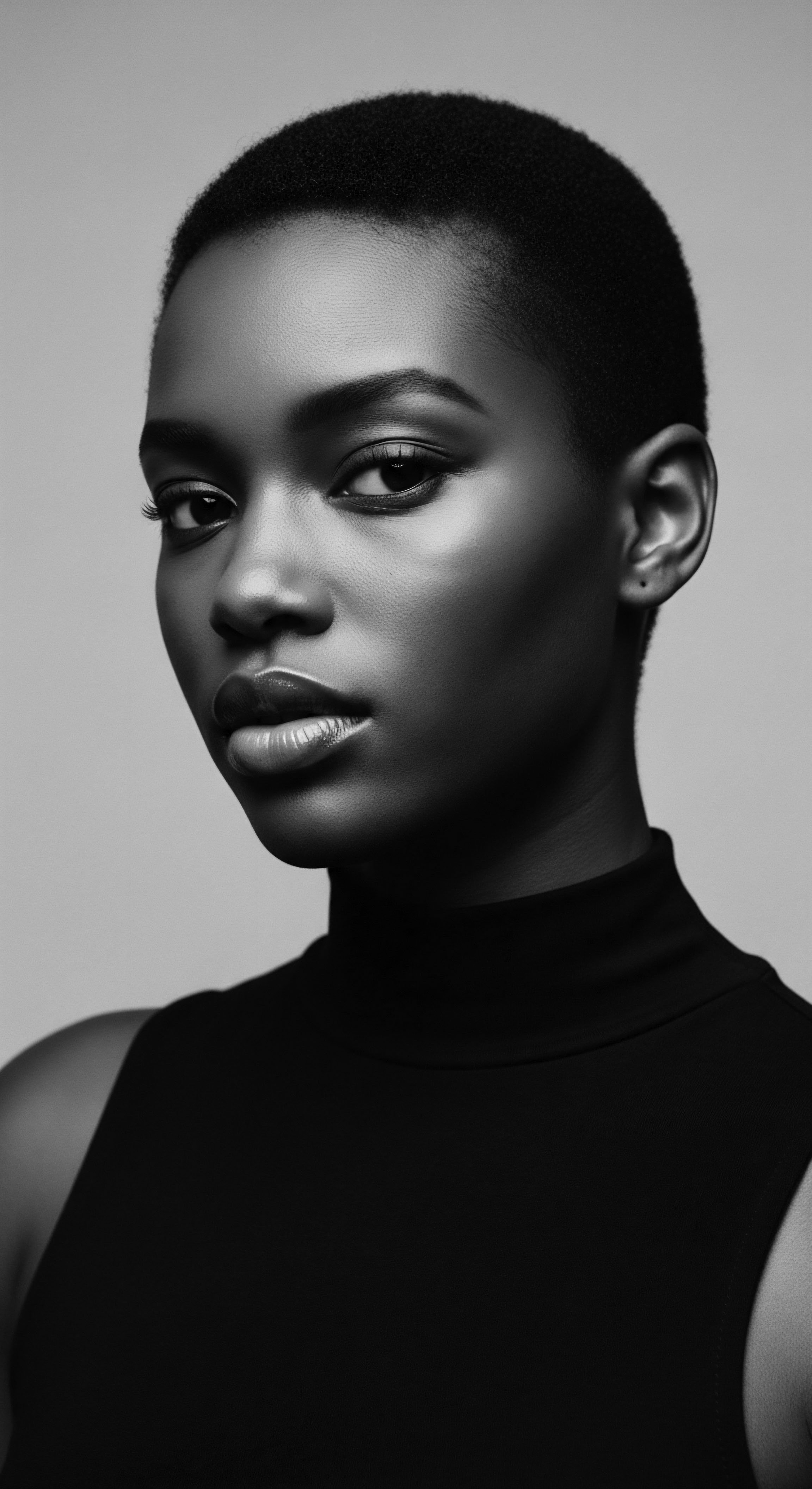
Roots
Consider the ancient African comb, not simply as a tool, but as a silent keeper of stories, a tangible echo of a heritage that reaches back across millennia. For those with textured hair, the act of styling and care connects us directly to ancestral practices, to a continuous lineage of ingenuity and self-expression. The materials chosen for these early combs were not random; they were selections born from deep understanding of natural resources, community wisdom, and the specific needs of coily, kinky, and wavy strands. These implements were sculpted from the very earth and living things around them, reflecting a profound relationship between people, their environment, and the sacred ritual of hair adornment.
The journey into understanding what materials comprised early African combs for textured hair begins with the foundational elements of life itself. From the sturdy embrace of various woods to the honed strength of bone and horn, each choice carried weight. These were resources gathered, shaped, and given new purpose, transforming raw materials into instruments of beauty and identity. They speak to a time when every object held a deeper meaning, when the act of grooming was intertwined with social status, spiritual belief, and communal well-being.

What Early African Environments Offered for Hair Tools?
Across the vast and diverse landscapes of the African continent, early communities drew upon their immediate surroundings to craft tools for daily life, including those for hair care. The savannahs offered resilient hardwoods, while coastal regions provided shells and marine materials. The presence of wildlife yielded bone, ivory, and horn, each with distinct properties that lent themselves to the creation of effective and often aesthetically pleasing combs. The knowledge of which materials were best suited for detangling, smoothing, or decorative purposes was a wisdom passed down through generations, a practical science rooted in ancestral observation.
This deep engagement with local flora and fauna ensured that early combs were not merely functional. They were imbued with the spirit of their origin, crafted with an understanding of how they would interact with the unique characteristics of textured hair. The wide-set teeth often seen in these ancient designs speak to an intuitive grasp of how to handle coils gently, minimizing breakage long before modern hair science provided scientific explanations.
Early African combs, forged from local natural resources, stand as enduring symbols of ancestral ingenuity and a profound connection to the land.

Wood Varieties and Their Properties
Wood was, perhaps, the most ubiquitous material for early African combs due to its widespread availability and ease of carving. Different regions favored particular species based on their hardness, grain, and symbolic associations.
- Hardwoods ❉ Species such as rubber wood and mahogany were favored in West Africa for their durability and smooth texture, allowing for delicate crafting and a gentle glide through dense hair.
- Olive Wood ❉ In North Africa, olive wood was often selected for its hardness and longevity, shaping combs that were both simple and robust.
- Red and Yellow Sandalwood ❉ These woods, prominent in South African combs, offered a variety of colors and were often adorned with hand-carved decorations, showcasing exquisite traditional craftsmanship.
- Sycamore Fig ❉ This wood was utilized in ancient Egypt for combs, demonstrating its suitability for fine, functional pieces, some of which exhibit evidence of extensive personal use.
The selection of specific wood often spoke to more than utility. Trees held spiritual significance in many African cultures, representing life, growth, or the presence of deities. A comb made from a particular tree might carry these symbolic properties, adding another layer to its personal and communal value.

Ritual
Beyond their practical application, early African combs were deeply woven into the fabric of communal ritual and individual identity. They were not simply instruments for disentangling strands; they participated in intimate ceremonies of care, celebration, and social declaration. The choice of material, the artistry of the carving, and the context of their use all contributed to a comb’s significance within the living traditions of textured hair heritage. Hair, itself often considered a spiritual gateway and a reflection of one’s inner and outer world, demanded tools crafted with intention and respect.
The deliberate creation of these combs transformed raw earth materials into objects that resonated with purpose. Consider how a comb, meticulously shaped from bone, might represent the strength and resilience of the animal it came from, transferring those qualities to the hair and its wearer. Or how a wooden comb, carved with symbols pertinent to tribal identity or social standing, became a wearable narrative, a silent testament to one’s place within the collective. This was an era where personal adornment, particularly hair styling, was a language understood by all, a complex system of communication that shaped social interactions and affirmed cultural ties.

What Was the Social Significance of Early Comb Materials?
In many African societies, the material composition of a comb served as a clear indicator of identity, social standing, or even spiritual belief. A comb crafted from a rare or difficult-to-acquire material, such as ivory, might be reserved for royalty or those of elevated status. The very act of possessing and using such a comb reinforced one’s position within the community. These objects became extensions of the wearer’s narrative, speaking volumes without uttering a single word.
The symbolism extended beyond mere wealth. Certain materials were associated with protective properties, fertility, or ancestral connection. For example, carvings on combs often depicted animals, plant forms, or geometric patterns, each carrying specific cultural meaning. These decorative elements, meticulously applied to the comb’s surface, transformed a grooming implement into a piece of portable art, a personal totem that carried cultural weight and historical memory.
Combs transcended mere function; they were cultural artifacts, signaling status, group affiliation, and spiritual reverence.

Bone, Ivory, and Horn ❉ Symbols of Prestige and Connection
Beyond wood, materials derived from animals held particular prominence, especially bone, ivory, and horn. These were often reserved for combs of greater artistic expression and symbolic value, given the effort required to acquire and sculpt them.
Bone and Antler offered durability and a fine texture when polished. Archaeological findings from ancient Kush and Kemet, modern-day Sudan and Egypt, reveal combs made from bone, often buried with their owners, highlighting the sacredness of hair and its accompanying tools. These combs were not just utilitarian; they were part of a deeper cultural practice, accompanying individuals even into the afterlife.
Ivory, sourced primarily from hippopotamus or elephant tusks, was a material of immense prestige. Its smooth, dense quality allowed for intricate carvings, making ivory combs highly prized possessions. Combs from ancient Egypt, dating as early as 3900 BCE, frequently featured elaborate animal motifs like giraffes, ostriches, and wildebeests, suggesting a connection to ritualistic hunting or festive occasions.
The presence of ivory combs in burials, such as the wide-toothed hippopotamus ivory comb with King Djet’s name engraved within a serekh, found in his First Dynasty tomb at Abydos, underscores their royal significance and enduring value. These objects were not merely decorative; they were markers of authority and spiritual power.
Horn, derived from cattle or buffalo, also played a role. When heated, horn could be shaped, becoming remarkably strong once cooled. Combs made from horn could be practical, yet also bear the hallmarks of careful craftsmanship. Predynastic Egyptian combs, specifically those used for lice removal, were at times carved from horn, alongside ivory and bone, demonstrating their utilitarian application alongside other esteemed materials.
(Martín Del Río Álvarez, 2018, p. 2). This specific use highlights a practical aspect of hair care in antiquity, where even tools for hygiene were crafted from available, durable resources.
The meticulous carving and decoration on these materials transformed them into cultural statements. They communicated messages of tribal identity, rank, fertility, and even protection. The act of holding such a comb was to hold a piece of history, a physical link to generations past and the collective heritage of a people.
| Material Source Wood (e.g. Mahogany, Sandalwood, Olive) |
| Characteristics Durable, varied textures, widely available, carvable |
| Associated Cultural Significance or Use Daily grooming, communal care, symbolic of life and growth, often passed down generations |
| Material Source Bone (Animal) |
| Characteristics Rigid, allows for fine teeth, smooth finish possible |
| Associated Cultural Significance or Use Archaeological finds often indicate funerary offerings, status symbol, linked to ancestral reverence |
| Material Source Ivory (Elephant, Hippopotamus) |
| Characteristics High prestige, smooth, dense, intricate carving capability |
| Associated Cultural Significance or Use Royalty, wealth, spiritual connection, elaborate decorative motifs, |
| Material Source Horn (Cattle, Buffalo) |
| Characteristics Malleable when heated, strong when cool, naturally curved forms |
| Associated Cultural Significance or Use Practical use, hygiene (e.g. lice combs), resourcefulness, communal value |
| Material Source Each material choice for early African combs was deeply intentional, reflecting both environmental availability and profound cultural meaning. |

Relay
The lineage of early African combs, sculpted from the earth’s bounty, continues to relay stories of resourcefulness, artistic mastery, and deep-seated cultural reverence for textured hair. This journey through time reveals how material choices were never arbitrary, but rather a profound interplay of environmental realities, evolving societal structures, and the enduring spiritual connection to personal adornment. Understanding the complexities of these ancestral tools allows us to appreciate how their design and substance were intimately linked to the daily rhythms of life, the expression of identity, and the preservation of communal well-being.
From the earliest archaeological findings to ethnographic observations of persisting traditional practices, a coherent narrative emerges. It illustrates how the practical function of detangling and styling coalesced with a powerful symbolic language. The materials themselves spoke, bearing witness to a society’s values, its relationship with the natural world, and its sophisticated understanding of aesthetics. This living archive of hair heritage reminds us that a comb was, and remains, a vessel of cultural memory.

How Did Material Availability Influence Comb Design and Utility?
The geographical distribution of resources across Africa naturally dictated the predominant materials used for combs in different regions. Communities in dense forest areas would have had abundant access to a variety of woods, leading to diverse wooden comb traditions. Pastoral societies, rich in livestock, would have found horn and bone readily available, shaping their comb-making practices accordingly.
This intimate relationship with local ecosystems meant that comb design was often a direct response to the specific properties of the chosen material. A bone comb, for instance, might be crafted with finer teeth for more precise styling, while a robust wooden comb might feature wider tines for detangling thicker, denser hair.
The longevity and durability of certain materials also played a significant role. Combs made from hardy woods, dense bone, or ivory were designed to withstand repeated use over many years, perhaps even a lifetime. These tools became personal companions, witnessing countless styling rituals and accumulating the patina of shared experience. Their construction spoke to a preference for tools that could be relied upon, reducing the need for constant replacement and reinforcing their value as enduring personal possessions.
Early African combs reflect a sophisticated adaptation of local materials to specific hair care needs and cultural expressions.

The Endurance of Wood and Bone in Archaeological Records
Archaeological excavations across Africa consistently unearth combs crafted from wood and bone, underscoring their historical prevalence and resilience. These findings provide tangible evidence of ancient hair care practices and the materials that sustained them. For instance, the renowned ‘Origins of the Afro Comb’ exhibition, which spanned 6,000 years of history, prominently featured ancient Egyptian combs made from bone and wood, showcasing their continuous use and evolution. This exhibition served to correct a common misconception that the Afro comb was a modern invention, tracing its roots deep into African antiquity.
A significant finding from this exhibition included a bone comb excavated from grave G78 in the southern cemetery at Abydos, Egypt, by archaeologist W.M. Flinders Petrie in 1898/1899. This comb, dating to approximately 3500 BCE, illustrates the early mastery of bone carving for functional and symbolic hair tools.
Its discovery, alongside a modern plastic Black Fist comb from the 1970s, starkly highlighted the unbroken lineage of textured hair care tools over millennia, linking ancient practices to contemporary cultural movements. The persistence of these materials in the archaeological record offers direct insight into the ingenuity and aesthetic sensibilities of early African societies.
In Nubia, a region closely intertwined with ancient Egypt, burial offerings have revealed a variety of personal items, including combs made from wood, bone, and ivory. These artifacts confirm the widespread use of such materials and the importance of grooming tools within funerary contexts, suggesting their value extended into the afterlife. A double-toothed wooden comb from the Late Nubian Christian Period (c.
1000-1400 AD), now housed at the Royal Ontario Museum, features both widely spaced teeth for detangling and fine teeth for smoothing, a design that resonates with modern hair care needs. This particular comb, likely carved from sycamore fig, demonstrates not only the practical design considerations but also the longevity of wood as a preferred material for textured hair care.

Metal and Shell ❉ Regional and Later Period Additions
While wood, bone, and ivory dominated earlier periods, other materials emerged in specific regions or later historical contexts.
- Shells ❉ Early combs dating back to around 5000 BCE in various parts of the world, including parts of Africa, sometimes incorporated animal shells. This resource would have been more prevalent in coastal or lakeside communities, offering a distinct aesthetic and texture.
- Metal ❉ As metallurgy developed, some communities began to craft combs from metals like brass or iron. These were often more durable and could be intricately worked, though perhaps less common for everyday use due to material cost and crafting complexity. Brass combs, for instance, are noted in historical records from some West African cultures.
The introduction of metal did not supplant the use of natural materials entirely, but rather added to the spectrum of choices available. This evolution in materials speaks to shifting technological capabilities, trade networks, and evolving aesthetic preferences within African societies, all while maintaining the fundamental purpose of honoring and caring for textured hair.

Reflection
As we stand at the crossroads of ancient wisdom and modern understanding, the early African comb emerges not as a relic of a distant past, but as a living testament to the enduring spirit of textured hair heritage. The materials chosen by our ancestors—the strong grain of wood, the honed resilience of bone, the precious gleam of ivory—speak volumes about their resourcefulness, their deep connection to the natural world, and their profound appreciation for the intrinsic beauty of coily and kinky strands. Each comb, whether simple or elaborately carved, whispers stories of identity, community, and the timeless ritual of care.
This exploration into the very composition of these ancient tools serves as a powerful reminder ❉ the care of textured hair is not a contemporary invention, but a practice rooted in millennia of tradition. It is a legacy passed down through generations, shaped by the land, imbued with cultural significance, and continually affirming self-worth. In every gentle detangling, in every precise part, in every artful adornment, we echo the hands that first sculpted these ancestral combs, honoring a heritage that flows from the roots of the earth to the very soul of each strand.

References
- CurlyTreats. Afro comb ❉ the cultural and political legacy behind this iconic hair tool. CurlyTreats, 2025.
- Geeshair. About African Wooden Combs. Geeshair, 2024.
- KOMA Club. The Hair Comb The Truth About Its Origin. KOMA Club, 2024.
- Martín Del Río Álvarez, C. Egyptian Predynastic Lice Combs ❉ Analysis of an Ancestral Tool. Trabajos de Egiptología. Papers on Ancient Egypt, 2018, 9, 1-24.
- Museum of Fine Arts, Boston. Gold and the Gods ❉ Jewels of Ancient Nubia. World History et cetera, 2014.
- Our Ancestories. The Evolution of the Afro Comb. Our Ancestories, 2021.
- Royal Ontario Museum. Hair comb. ROM Collections, 2024.
- Saint Louis Art Museum. Nubia ❉ Treasures of Ancient Africa. Saint Louis Art Museum, 2021.
- Tan Mujiang. Sustainable Beauty ❉ Exploring Centuries of Hair Combs. Tan Mujiang, 2023.
- The Fitzwilliam Museum, University of Cambridge. Origins of the Afro Comb. The Fitzwilliam Museum, 2013.
- University College London. ‘African Hair Combs’ – a Conservator’s comment. UCL Blogs, 2013.
- Walters Art Museum. Comb. The Walters Art Museum, 2024.
